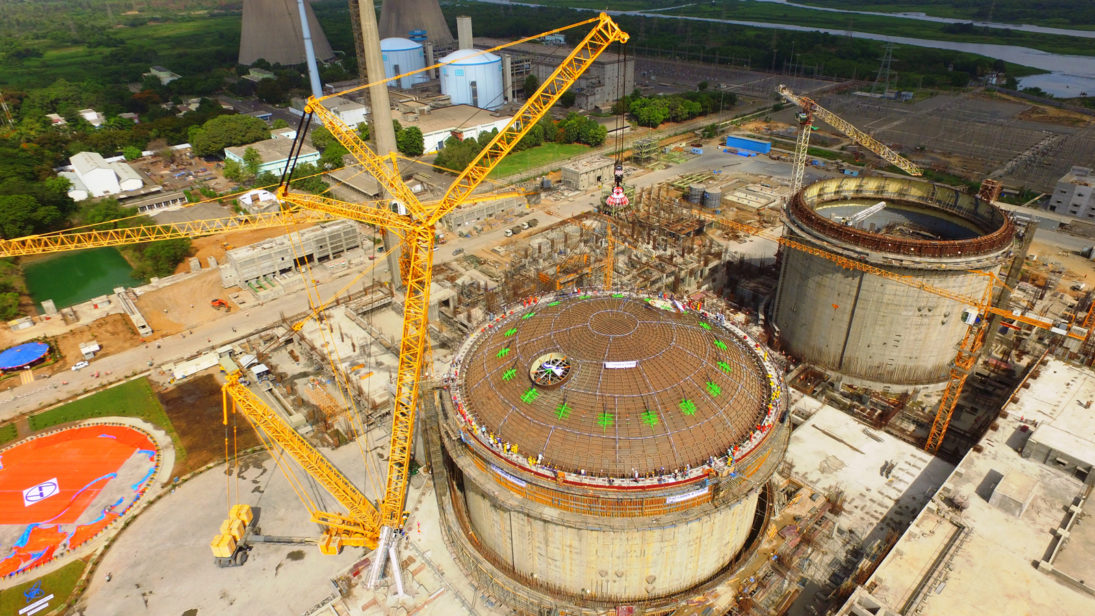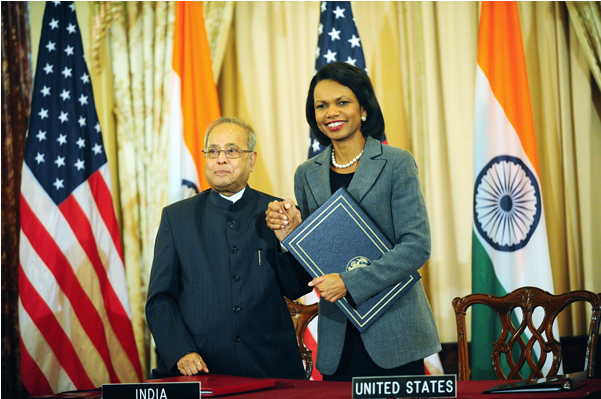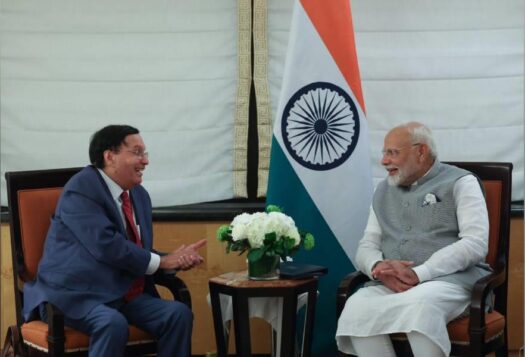
On October 8, 2008, President George W. Bush signed the United States-India Nuclear Cooperation Approval and Nonproliferation Enhancement Act into law. Two days later, a historic agreement was concluded between the world’s oldest and largest democracies allowing for bilateral civilian nuclear cooperation whereby American utilities could build nuclear reactors for India and supply them with uranium fuel. This would meet India’s rising need for electricity as well as contributing toward its broader mission of diversifying its energy mix to ensure energy security.
Fast forwarding to 2018, Indian critics of the deal question whether this very promise was kept, as the six reactors to be built by American nuclear giant Westinghouse in Andhra Pradesh are yet to be constructed after a decade. From a point of critical inquiry, one might ask: has the bilateral U.S.-India civilian nuclear cooperation even kicked off? However, to view the deal’s outcome in such simplistic terms would imply taking a narrow view of the impact it has had on the relationship.
The civilian nuclear deal has facilitated gains for both sides–for India, it brought a recognition of its nuclear legitimacy while for the United States, it mitigated nuclear proliferation concerns about India while also providing the United States with a counterweight to a rising China.
History of U.S.-India Nuclear Engagement
Prior to 2005, Indo-U.S. relations were hostage to a nuclear past, which prevented any significant forward movement in the relationship. Post India’s peaceful nuclear explosion in 1974, the bilateral relationship was put on a hiatus in the nuclear realm, as the United States stopped supplying uranium fuel for India’s Tarapur reactor. The United States viewed India’s test as a breach of trust because Washington had provided nuclear support to New Delhi under the ‘Atoms for Peace’ program, which India had promised to use only for civilian purposes. On the other hand, India also felt betrayed because the nuclear fuel contract was suddenly paused by the United States, despite the fact that the nature of India’s tests was peaceful.
Subsequently, India experienced three decades of global nuclear commerce isolation due to sanctions and this prevented any further transfer of dual use technologies to India and more specifically, civilian nuclear equipment technology. According to Raymond E. Vickery, former U.S. Assistant Secretary of Commerce and Trade, “this theme of unreliability based upon the failure to fulfill the fuel supply agreement for Tarapur became a continuing complaint of India in regard to doing business with the United States.”[1]
A Nuclear Opening: Benefits of the Deal
The conclusion of the deal freed both countries of the baggage of this nuclear past and brought them together to tap strategic and economic synergies. While the shared values of democracy have always existed between the two countries, the utility in expanding the canvas of bilateral cooperation truly played out when the nuclear irritant was removed in 2005 and the United States offered India civilian nuclear technology.
Even if the direct commercial benefits of the deal are yet to be seen, it helped India achieve an immense strategic and diplomatic gain–an exclusive waiver from the Nuclear Suppliers Group (NSG), giving India the opportunity to do nuclear trade with 46 member countries. This was inconceivable many years prior since as a non-Nuclear Nonproliferation Treaty (NPT) member and de-facto nuclear power, India was prohibited to engage in nuclear commerce. What’s significant is that not only was the formation of the NSG a reaction to the Indian nuclear tests in 1974, but the United States’ own nuclear nonproliferation laws underwent modification in response to these tests. Thus, India’s securing an NSG waiver was a huge symbolic win, in a way validating its status as a nuclear power, and this U.S. support has continued in recent years, with the last three American administrations backing India’s bid for NSG membership.
One can further argue that the nuclear deal stood for much more than just a commercial partnership between India and the United States in the civilian nuclear realm—it was reflective of a fundamental shift in both countries’ perception of each other. Before the deal, the United States was known to extend nuclear technology and cooperation only to allies, such as South Korea and Japan. But with this deal, the United States offered such technology to a non-ally like India. The calculus was to enlist New Delhi’s help to balance against China’s rise and this strategy has paid dividends with India shoring up its defense capabilities by buying American weapons worth billions, playing more of a net security provider role in the Indian Ocean, and aligning its regional and global interests more closely with the United States.
Additionally, by getting India to put its civilian nuclear reactors under the IAEA safeguards regime, the deal laid the foundation for India to align its nuclear policy posture further with the U.S.-led global nonproliferation regime. This can be seen through India becoming party to multilateral nuclear security and safety initiatives such as the Convention of Supplementary Compensation on Nuclear Damage and the Convention on the Physical Protection of Nuclear Material, attending nuclear security summits, and establishing the Global Center for Nuclear Energy Partnership, a center for excellence that facilitates the exchange of nuclear best practices among countries. These were direct nuclear nonproliferation gains from the deal for the United States.

Where the Deal Fell Short
The United States had perceived significant economic gains from civilian nuclear cooperation with India in the long term, which have yet to pan out. When the deal was freshly concluded, the U.S. nuclear energy industry was looking forward to selling nuclear reactors to the Indian market, especially in the context of an expected nuclear energy resurgence with a dozen newcomers sprinting to adapt nuclear energy along with India and China that planned to expand nuclear energy development. The United States viewed the Indian nuclear market as “a rich prize” that could provide U.S. companies to opportunity to make billions of dollars by constructing nuclear power plants in the country. In this context, American companies such as General Electric and Westinghouse were looking at a potential business of $150 billion from the nuclear markets in India.
However, the agreement to make nuclear reactors was significantly delayed, and finally came only in 2016, because legalities dealing with compensation in case of a nuclear accident needed to be sorted out. India was trying to negotiate with the United States to establish clear liabilities for the operator as well as vendors in case of a nuclear accident and come up with a nuclear insurance pool that would look after compensation for damage. Though that hurdle was crossed, Westinghouse’s recent filing for bankruptcy has stalled progress again, with doubts on whether the company would be able to fulfill its commitment. However, there is still hope for the U.S. nuclear energy industry in India–according to media reports, the Westinghouse bankruptcy issue is nearly resolved and the company has restarted conversations with India on constructing the six nuclear reactors.
Lasting Impact
India’s nuclear activities were a concern for the United States for decades and the main cause for their deep estrangement. However, the U.S.-India civilian nuclear deal reversed this estrangement and turned it into engagement, which in the last ten years has evolved into a grand strategic partnership. Some big achievements of the partnership include convergence on regional security issues, India becoming a “major defense partner” of the United States, the various foundational agreements signed that improve interoperability between U.S. and Indian forces, joint military exercises, expansion of trade relations, and cooperation on countering terrorism, to name a few. Had the nuclear irritant not been removed, would the strategic partnership have blossomed as fully? Thus, to measure the success of the nuclear deal simply in commercial terms may not be wise as it paved the way for some symbolism but a lot of substance in U.S.-India relations, elevating it to one of the most promising partnerships in the last decade.
[1] Raymond E. Vickery Jr. ( 2011), “The Eagle and the Elephant: Strategic Aspects of US-India Economic Engagement,” Woodrow Wilson Center Press, pp.35
***
Image 1: Reetesh Chaurasia via Wikimedia
Image 2: U.S. Department of State


